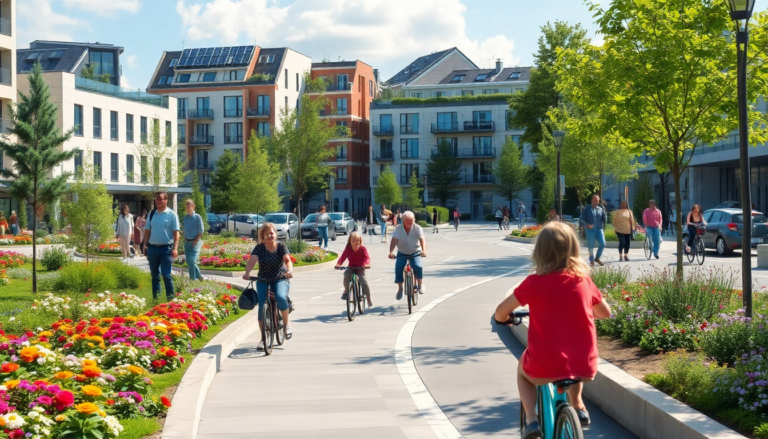Argomenti trattati
When you think of city life, what comes to mind? Bustling streets filled with honking cars, perhaps? Or maybe a serene park where children play freely? The 2025 City Ranking has flipped the script, shining a light on cities that prioritize both sustainable mobility and the well-being of children. It’s fascinating to see how urban environments are evolving to create safer, healthier spaces for the next generation. After evaluating 36 European cities based on school traffic policies, speed limits, and protected bike lanes, the results reveal a compelling narrative about urban design and its impact on families.
The rise of child-friendly urban planning
In recent years, there’s been a growing awareness of the importance of making our cities not just livable, but also friendly for children. The report highlights how urban areas are taking significant steps to integrate safety, accessibility, and sustainability. For instance, the concept of school streets—where traffic is limited during drop-off and pick-up times—has gained traction. It’s not just about reducing congestion; it’s about fostering a sense of security for kids as they navigate their neighborhoods. I remember visiting a city where the streets transformed into vibrant playgrounds during school hours; it felt like a breath of fresh air amidst the usual chaos.
The top ten cities leading the charge
Now, let’s dive into the cities that made the top ten. Starting at number ten, we have Ghent, Belgium. This medium-sized city has implemented bold initiatives to reduce traffic, designing numerous low-traffic zones that encourage walking and cycling. In ninth place, Oslo stands out with a score of 48%, having drastically reduced car usage in favor of bikes. It’s a city that exemplifies a commitment to eco-friendly transportation. Bristol follows closely behind, also scoring 48%. The city has introduced areas with speed limits of just 30 km/h, enhancing safety for pedestrians and cyclists alike.
Barcelona and Helsinki: A closer look
Barcelona shines in seventh place, with its innovative network of superblocks that prioritize pedestrian space over vehicular traffic. It’s a revolutionary approach that many cities are now looking to replicate. Meanwhile, Helsinki, at sixth place, boasts one of the best cycling infrastructures, confirming its status as a leader in Nordic excellence. The Finnish capital’s commitment to creating a bike-friendly environment is palpable, and I can’t help but think how wonderful it would be to cycle along its scenic routes.
Food for thought: Lyon and Brussels
At number five, we have Lyon, the gastronomic capital of France, scoring impressively in the ranking. Interestingly, Brussels comes in fourth place, showcasing how the city has embraced sustainable practices in its urban planning. These cities are not just about aesthetics; they’re about creating a lifestyle that promotes health and safety.
The giants: Antwerp, Amsterdam, and Paris
As we reach the top three, Antwerp takes the bronze medal. It excels in combining school routes with safe cycling paths, making it a model for others to follow. Then we have Amsterdam, famously known as the cycling capital of the world, claiming the second spot. With its vast network of bike lanes and policies that support cycling, it’s no wonder Amsterdam continues to be a beacon of sustainable mobility.
And at the pinnacle? Paris. The French capital secured the top spot with a remarkable score of 79%. Paris isn’t just about the Eiffel Tower and croissants; it’s a city dedicated to creating safe school streets, protected cycling networks, and effective speed reduction policies. This transformation is a testament to what committed urban planning can achieve.
Italian cities in the spotlight
The 2025 ranking also shines a light on various Italian cities. Bologna, leading the way, scored 40%, thanks to its school streets that are closed to traffic during peak hours, along with multiple 30 km/h zones and protected bike lanes. It’s inspiring to see how cities can adapt and prioritize the safety of their youngest residents. Following Bologna is Milan, with 33%, as the bustling metropolis invests in future projects aimed at enhancing its urban mobility.
Turin, with a score of 32%, is making strides but still grapples with a fragmented cycling network. And let’s not forget Florence and Rome, which also made the list, albeit further down. These cities demonstrate that with strategic planning, urban environments can significantly reduce accidents, protect children and cyclists, and encourage a more active lifestyle while lessening environmental impact.
A vision for the future
As we look towards the future, it’s encouraging to see how cities are reshaping their landscapes to better serve families and the environment. The 2025 City Ranking serves as a roadmap, highlighting the potential of urban planning to create spaces where children can thrive safely. In my view, the integration of sustainable practices in city design is not just a trend; it’s a necessity. As many know, a child-friendly city is a healthier city for everyone.

